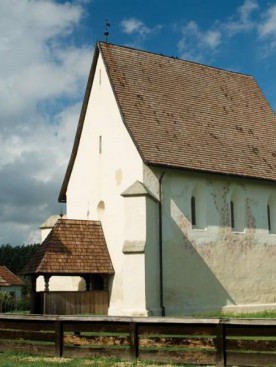The Calvinist Church – MárokpapiThis commune came into being in 1941 through the merger of two settlements: Márok and Papi. The village is famous because of its Calvinist church, which was in fact the place of worship built in the medieval village of Márok. The origin of the name Márok is the name Márk (Mark). In the Middle Ages, the village was part of the Kisvárda estate; but in 1566, Crimean Tatar troops set it on fire. The church of the village, dedicated to The Holy Mary, was mentioned already at the beginning of the 14th century. Later, starting with the second half of the 16th century, the Calvinists began using the church. The mural paintings inside the church were described first by the end of the 19th century. However, these were covered with lime coating later. The church was hit by lightning in 1939 and burned down. The alternative of demolishing the church has been taken into consideration then, but fortunately such a thing did not happen. As a result of the explorations initiated in 2000 and the subsequent restoration work, this church now serves its congregation as a spectacular feat of architecture and also welcomes visitors. A fifteen metres high belfry built in the 18th century and renovated during the second half of the 19th century stands in front of the western frontispiece. The bell was cast in 1791. The Gothic style gate having a stone frame is also located on the western wall. A special embellishment on the external frontispiece is the coloured painting with floral motifs stemming from the 17th century, from the period when already the Calvinists used the Church. Similar mural decorations can be found in several places in the area, for instance, in Csaroda, Lónya and Vámosatya. Inside, one can see medieval frescoes painted in the first half of the 15th century. These were uncovered in 1999, when the church was restored. On the northern wall of the nave The Three Wise Men were depicted, while the scene on the chancel arch shows how angels carry the lifeless body of Christ to the heavens. This chancel arch separates the nave from the sanctuary covered by a ribbed groin vault ceiling. On the southern side of the sanctuary, there is a sedilia spanned by a trefoil arch and opposite to it a sacristy entrance spanned by a lancet arch. Researchers found a badly damaged tabernacle east to this doorway. In what concerns the period when the church had been built, it is certain that the place of worship already stood, when its priest was mentioned, i.e., in 1332. At the end of the 13th century, the ownership of the settlement was a matter of contention. Most probably, the church was built after the matter had been settled by a ruling of the king at the end of a lawsuit in 1299, that is, between 1300 and 1332. The nave and the sanctuary were built in the same period. Researchers found no evidence of earlier buildings whatsoever. |












